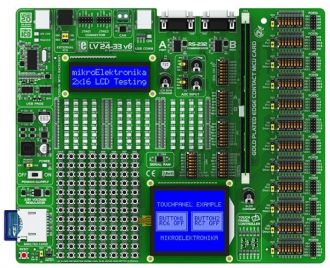
We strongly encourage users to use Package manager for sharing their code on Libstock website, because it boosts your efficiency and leaves the end user with no room for error. [more info]

Rating:
Author: MIKROE
Last Updated: 2016-02-20
Package Version: 1.0.0.0
Example: 1.0.0.0
Category: Development Systems
Downloaded: 1098 times
Followed by: 1 user
License: MIT license
Examples for LV24-33 v6 development system
Do you want to subscribe in order to receive notifications regarding "LV24-33 v6" changes.
Do you want to unsubscribe in order to stop receiving notifications regarding "LV24-33 v6" changes.
Do you want to report abuse regarding "LV24-33 v6".
| DOWNLOAD LINK | RELATED COMPILER | CONTAINS |
|---|---|---|
| 1354269797_lv24_33_v6_mikroc_pic24.rar [740.65KB] | mikroC PRO for dsPIC30/33 & PIC24 |
|
| 1354269868_lv24_33_v6_mikrobasic_pic24.rar [743.82KB] | mikroBasic PRO for dsPIC30/33 & PIC24 |
|
| 1354269939_lv24_33_v6_mikropascal_pic24.rar [735.77KB] | mikroPascal PRO for dsPIC30/33 & PIC24 |
|

LV24-33 v6 development system provides a development environment for programming and experimenting with dsPIC33 and PIC14 microcontrollers from Microchip.The system includes an on-board programmer with mirkoICD providing an interface between the microcontroller and PC. Numerous modules, such as 128x64 graphic LCD, alphanumeric 2x16 LCD, etc, are provided on the board and allow you to easily simulate operation of the target device.
Provided examples are written for:
PIC24FJ96GA010
Examples:
-- A/D conversion and displaying conversion results on LCD.
-- Examples of SPI communication.
-- Detection of button pressed on port B.
-- Displaying text on LCD.
-- Displaying text and images on Graphic LCD.
-- Examples of I2C communication.
-- Examples of RS485 communication.
-- Sending data to a PC via serial communication.
-- Sending data from PS/2 keyboard.
-- Examples of reading and writing data to MMC or CF cards.
-- Touch Screen demonstration example.